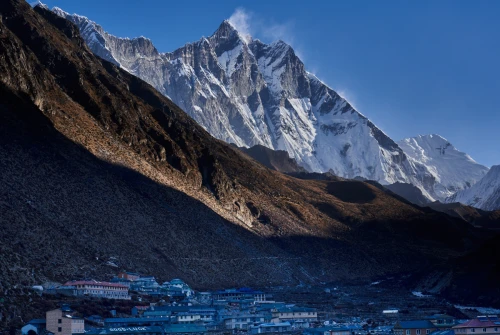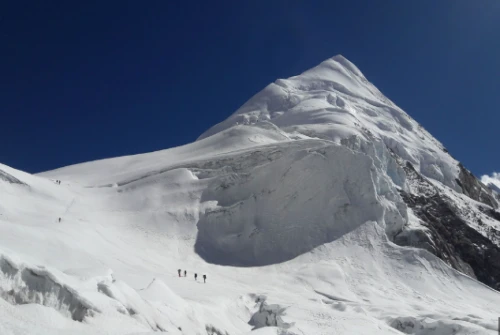The Pikey Peak Trek in Nepal is a hidden Himalayan treasure that unveils an untouched side of the Everest region. Nestled in the less-traveled lower Solukhumbu, this trail offers trekkers a chance to experience the magnificence of the Himalayas without the throngs of people found on more popular routes like the Everest Base Camp trek. With serene landscapes, sweeping mountain views, and a deep connection to the Sherpa culture, Pikey Peak presents an unforgettable adventure for those seeking both peace and adventure.
Named after a local Sherpa deity, Pikey Peak is a sacred site in the region, and its summit, adorned with colorful prayer flags, serves as an offering to the mountain gods. The journey along this trail is an exploration of not just the natural beauty of the Himalayas, but also the rich spiritual traditions and warm hospitality of the Sherpa communities. With well-maintained trails, cozy teahouses, and quaint villages, the Pikey Peak trek immerses you in the real, unspoiled Himalayan way of life. It’s an ideal route for those who want to connect with nature, culture, and the majestic peaks without reaching altitudes above 5,000 meters.
Why Choose the Pikey Peak Trek?
The Pikey Peak Trek is the ideal journey for trekkers who desire solitude, panoramic Himalayan vistas, and authentic cultural experiences away from the bustling routes of Everest Base Camp. It’s one of the rare treks where you can witness sunrise views that include eight of the highest mountains in the world: Everest, Kanchenjunga, Lhotse, Makalu, Dhaulagiri, Manaslu, Annapurna, and Gauri Shankar from a single vantage point.
What makes it even more exceptional is the serenity of the path; here, trekkers enjoy peaceful trails through dense forests, rolling meadows, and untouched hamlets. It’s not just a trek, it’s a soulful journey that blends physical challenge with deep cultural immersion. Whether you are a first-timer in Nepal or a repeat visitor looking for a new route, Pikey Peak provides a fresh and deeply fulfilling Himalayan experience that rivals even the classic trails.
Panoramic Views of the Highest Peaks
Pikey Peak (4,065m) offers one of the most astonishing Himalayan views found anywhere in Nepal. On a clear morning, trekkers are treated to a 180-degree panorama of snow-capped peaks that includes the towering presence of Mount Everest, along with other famed summits such as Lhotse, Makalu, Annapurna, Kanchenjunga, Dhaulagiri, and more.
What makes this view unique is its unobstructed nature; since the peak is not surrounded by higher mountains, it provides a clean skyline dominated by legendary Himalayan giants. Watching the first rays of sun paint these peaks gold is a moment of transcendencem an experience that even Sir Edmund Hillary regarded as his favorite in all of Nepal.
For photography enthusiasts and mountain lovers, this trek offers countless picture-perfect moments from ridgelines, hilltops, and peaceful alpine clearings.
Off-the-Beaten-Path Experience
In a country increasingly popular among global trekkers, Pikey Peak remains refreshingly untouched. The trail avoids the well-worn paths of commercial trekking and takes adventurers deep into the heart of Sherpa territory, where age-old customs are still practiced and preserved.
You’ll pass through tiny stone villages, yak pastures, pine forests, and Buddhist monasteries that feel frozen in time. This trek presents a golden opportunity to walk at your own pace, free from the queues and hustle of more popular routes. You will interact with locals who are genuinely welcoming, curious about visitors, and proud to share their culture.
Staying in family-run teahouses provides not just a bed and meal, but heartfelt conversations and glimpses into the lives of mountain people. The authenticity, quietude, and simplicity of the Pikey Peak trail are what make it one of the most enriching treks in Nepal.
Pikey Peak Trek Overview
The Pikey Peak Trek is a moderately challenging trek that offers a fantastic Himalayan adventure without the crowds typically associated with Everest Base Camp. Spanning between 7 to 9 days, depending on your pace and itinerary, the trek begins in either Dhap, which you can reach by an 8-10 hour drive from Kathmandu, or Phaplu, where you can fly in. Both entry points lead to the Solu region, an area rich in both natural beauty and cultural heritage.
The highest point of the trek is Pikey Peak at 4,065 meters, which offers breathtaking views of the Himalayas, including Mount Everest, Makalu, Lhotse, and Kanchenjunga. The climb to the summit of Pikey Peak does not require technical climbing skills, and the gradual altitude gain makes the trek suitable for trekkers with moderate fitness levels. The trek is ideal for beginners who have some prior hiking experience or for those who want a less strenuous alternative to the more popular Everest routes.
The trek passes through the Gaurishankar Conservation Area, which is not only known for its striking landscapes but also for its rich ecological diversity. Along the way, trekkers will walk through dense rhododendron forests, cross dramatic suspension bridges, visit serene Buddhist monasteries, and engage with the hospitable Sherpa communities in remote villages.
This trek offers a peaceful alternative to the more crowded trekking routes, combining both nature and culture in one immersive experience.
Cultural Immersion and Sherpa Hospitality
One of the richest elements of the Pikey Peak Trek is the deep immersion into Sherpa culture. Unlike more commercial trails, the communities here have preserved their traditions with pride. You'll visit centuries-old monasteries adorned with prayer wheels, frescoes, and butter lamps that reflect the Buddhist faith that guides these communities.
The villages of Junbesi and Jhapre are cultural hubs where you can witness monks in prayer, local festivals, and traditional architecture. Food is homemade and deeply nourishing—dal bhat, buckwheat pancakes, potato curry, yak butter tea, and momos are not just meals, but cultural experiences. Homestays and small teahouses provide not just a place to sleep, but a window into Sherpa daily life.
Stories shared by your hosts around the fireplace or during dinner linger long after the trek ends. These personal interactions are the soul of the Pikey Peak experience.
Flora and Fauna on the Trail
The Pikey Peak trail is a botanical wonderland, especially in spring when rhododendrons bloom in every shade of red, pink, and white. The route traverses through mixed forests of pine, fir, magnolia, and bamboo, transitioning into alpine meadows filled with wildflowers.
The forested zones are rich in biodiversity. Keep your eyes peeled for Himalayan monals (Nepal’s national bird), eagles, vultures, and even elusive animals like the red panda or Himalayan black bear, though sightings are rare.
The trek also passes by yak herding grounds and agricultural terraces that demonstrate the harmonious relationship between humans and nature in this region. This vibrant mix of flora and fauna enhances the sensory experience of the trek and reinforces its standing as one of Nepal’s best-kept secrets for nature lovers.
Trekking Logistics
To trek Pikey Peak, you’ll need a Gaurishankar Conservation Area Permit (GCAP) and a TIMS card (Trekkers’ Information Management System). These are easily obtained in Kathmandu or through trekking agencies.
Accommodations consist of teahouses with basic yet comfortable amenities—simple wooden beds, shared bathrooms, and hearty meals. The rooms are usually unheated, so warm sleeping bags are essential for a comfortable night's sleep. Food along the trail is locally sourced and includes energy-rich items like rice, lentils, noodles, soup, and boiled eggs. Internet access is sporadic, and mobile signals are limited to certain sections.
Hiring a guide and porter is highly recommended for navigation, cultural interpretation, and to support the local economy. Most importantly, respect local customs, walk clockwise around stupas, remove shoes before entering homes or monasteries, and ask before taking photographs of people.
When to Go: Best Seasons Explained
The ideal seasons for the Pikey Peak Trek are spring (March to May) and autumn (September to November). During spring, the forests explode in color with rhododendron blooms, and temperatures are moderate, making it a vibrant and photogenic time to trek.
Autumn offers the clearest skies and stable weather, with crisp mornings and excellent visibility across the Himalayas. These months also coincide with Nepal’s major festivals like Dashain and Tihar, providing additional cultural experiences. While winter (December to February) is doable with proper gear, expect snow at higher altitudes and colder nights.
Monsoon season (June to August) brings heavy rains, leeches, and slippery trails—less ideal for trekking but stunningly lush if you’re experienced and adventurous.
Physical Preparation and Gear Checklist
Although Pikey Peak is a moderate trek, good preparation enhances enjoyment and safety. Begin training 4-6 weeks in advance with daily walks, stair climbing, and cardiovascular workouts. Strengthen your core and legs to handle uphill and downhill sections.
No technical climbing is involved, but long walking days require stamina. Your packing list should include high-quality trekking boots, layered clothing (thermal base, fleece, and down jacket), windproof outer layers, gloves, a beanie, sunglasses, sunscreen, reusable water bottles, purification tablets, and a sleeping bag rated to -10°C.
Don’t forget trekking poles, headlamps, extra batteries, and a basic first-aid kit. Lightweight, moisture-wicking materials and a good backpack with rain cover are essentials. Prepare well and you’ll be able to fully enjoy every step of this magnificent journey.
Pikey Peak vs. Everest Base Camp – A Comparative Insight
While Everest Base Camp is the crown jewel of Himalayan trekking, Pikey Peak offers an alluring alternative. EBC is longer, more crowded, and higher in elevation reaching 5,364 meters whereas Pikey Peak is shorter, less strenuous, and tops out at 4,065 meters. What EBC lacks in solitude, Pikey Peak delivers in abundance.
It offers equally stunning views of Everest, plus the chance to experience traditional Sherpa life in a more authentic setting. EBC often feels commercial; Pikey Peak is still raw and real. Moreover, you don’t need to fly to Lukla, avoiding logistical delays and high costs. If you want Everest views, cultural depth, and peaceful trails without going to extremes, Pikey Peak is undoubtedly the superior choice for offbeat adventurers.
Environmental Responsibility
The remote beauty of the Pikey Peak region comes with a responsibility to preserve its ecological and cultural heritage. We encourage all trekkers to follow Leave No Trace principles, pack out all waste, avoid single-use plastics, and stick to marked trails to protect fragile plant life. Use local guides and stay in community-based lodges to support sustainable tourism.
Water purification tablets reduce plastic bottle use, and reusable utensils minimize garbage. Dress modestly and be respectful at religious sites. Tourism here is still in its early stages, so your actions can have a lasting impact on both the environment and local livelihoods. By trekking responsibly, you not only protect the natural landscape but also ensure future generations can enjoy this pristine Himalayan sanctuary.
Final Thoughts
Pikey Peak Trek is a dream for every traveler who yearns for genuine Himalayan magic away from the commercial chaos. From its divine sunrise views and peaceful trails to its deeply rooted Sherpa culture and biodiversity, every aspect of this journey leaves a lasting impression. It’s a trek that offers the grandeur of Everest without the altitude stress or crowd fatigue. Perfect for seasoned trekkers and beginners alike, Pikey Peak invites you to walk in peace, immerse in local life, and gaze upon the world’s tallest peaks in utter solitude. Pack your bags, lace your boots, and take the trail that leads not just to a mountain—but to the soul of Nepal.


 based on 9 reviews
based on 9 reviews
